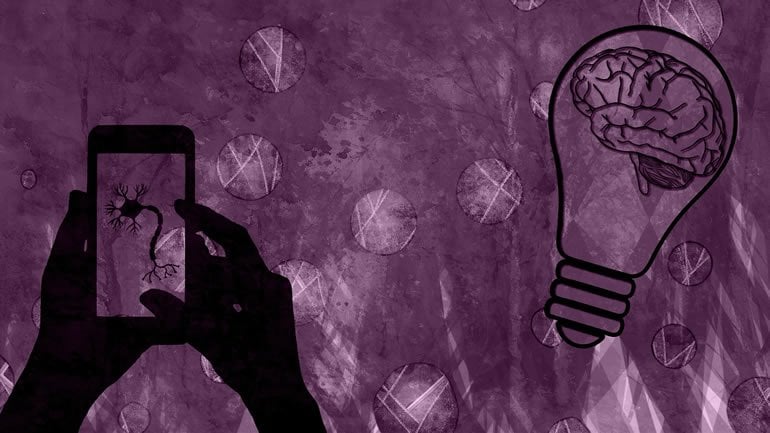Summary: Researchers have identified a bio-chemical circuit that supports neuron-microglia communication. When neurons are active, they release ATP. Microglia sense extracellular ATP and the compound draws the immune cell toward the neuron.
Source: Mount Sinai Hospital
Immune cells in the brain that act as scavengers to remove dying cells also play a potentially pivotal role in the regulation of behavior in both mice and humans, a research team from Mount Sinai has found. The newly identified function of the scavenger cells, known as microglia, to protect the brain from abnormal activation in health and disease has implications for treating behavioral abnormalities associated with neurodegenerative and inflammatory diseases in humans.
The study was published September 30, 2020 in Nature.
“When we think about brain function, we typically think about how neurons control our thoughts and behavior,” says Anne Schaefer, MD, PhD, Professor of Neuroscience, and Psychiatry, at the Icahn School of Medicine at Mount Sinai, and senior author of the study.
“But the brain also contains large amounts of non-neuronal cells, including microglia, and our study puts a fresh spotlight on these cells as partners of neurons in the regulation of neuronal activity and behavior. We found that microglia can sense and respond to neuronal activation and provide negative feedback on excessive neuronal activity. This novel microglia-mediated mechanism of neuromodulation could play an important role in protecting the brain from disease.”
Mount Sinai researchers identified the biochemical circuit that supports neuron-microglia communication. When neurons are active, they release a molecule called adenosine triphosphate (ATP). Microglia can sense extracellular ATP, and the compound draws them toward the active neurons. As the next step, the microglia break ATP down to generate adenosine, which then acts on adenosine receptors on the surface of active neurons to suppress their activity and prevent excessive activation.
“In inflammatory conditions and neurodegenerative diseases like Alzheimer’s, microglia become activated and lose their ability to sense ATP and to generate adenosine,” says Ana Badimon, PhD, a former student in the Schaefer Lab and first author of the study.
“This suggested to us that behavioral alterations associated with disease may be mediated, in part, by changes in microglial-neuron communication,” adds Dr. Schaefer, who is also Co-Director of the Center for Glial Biology at The Friedman Brain Institute at the Icahn School of Medicine.
Dr. Schaefer describes the identification of the biochemical circuit that enables microglial control of neuronal responses as a potential “paradigm shift” in our understanding of how innate immune cells in the brain can contribute to behavior.
This observation is particularly important, she adds, given the fact that microglia, while residing in the brain, are uniquely equipped to also respond to signals generated in the peripheral body. Microglia can therefore act as an interface between peripheral body changes, like a viral infection, and the brain by communicating these signals to neurons to modulate behavioral responses.
By shedding valuable light on the interaction of neurons and microglia, the study carries a number of practical implications for further research. They range from novel approaches of neuromodulation of normal behaviors by targeting microglia, to potential treatment of behavioral abnormalities associated with neurodegenerative diseases.

“The future promise of our study also lies in the identification of novel signals like ATP that will allow microglia to modulate the function of highly diverse neurons, including neurons controlling sleep or metabolism,” says Dr. Schaefer. “We believe our work has the potential to add to our knowledge about the mechanisms of neuromodulation.”
Other partners in the Mount Sinai-led study include California Institute of Technology, the Nagoya University Graduate School of Medicine in Japan, Kobe University Graduate School of Medicine in Japan, University of Minnesota, and Harvard Medical School.
Funding: The research described in this press release is funded in part by the National Institutes of Health, The Brain and Behavior Research Foundation, The Whitehall Foundation, and The Edward Mallinckrodt Jr. Foundation.
The National Institute on Aging, part of the National Institutes of Health, recently awarded the Icahn School of Medicine at Mount Sinai a $2.99 million grant (number RF1AG068558) that will enable Dr. Schaefer and colleagues to investigate the epigenetic mechanisms of systems microglia activation during aging and its contributions to neurodegenerative diseases.
About this neuroscience research article
Source:
Garvan Institute of Medical Research
Contacts:
Elizabeth Dowling – Mount Sinai Hospital
Image Source:
The image is in the public domain.
Original Research: Closed access
“Negative feedback control of neuronal activity by microglia” by Anne Schaefer et al. Nature.
Abstract
Negative feedback control of neuronal activity by microglia
Microglia, the brain’s resident macrophages, help to regulate brain function by removing dying neurons, pruning non-functional synapses, and producing ligands that support neuronal survival1. Here we show that microglia are also critical modulators of neuronal activity and associated behavioural responses in mice. Microglia respond to neuronal activation by suppressing neuronal activity, and ablation of microglia amplifies and synchronizes the activity of neurons, leading to seizures. Suppression of neuronal activation by microglia occurs in a highly region-specific fashion and depends on the ability of microglia to sense and catabolize extracellular ATP, which is released upon neuronal activation by neurons and astrocytes. ATP triggers the recruitment of microglial protrusions and is converted by the microglial ATP/ADP hydrolysing ectoenzyme CD39 into AMP; AMP is then converted into adenosine by CD73, which is expressed on microglia as well as other brain cells. Microglial sensing of ATP, the ensuing microglia-dependent production of adenosine, and the adenosine-mediated suppression of neuronal responses via the adenosine receptor A1R are essential for the regulation of neuronal activity and animal behaviour. Our findings suggest that this microglia-driven negative feedback mechanism operates similarly to inhibitory neurons and is essential for protecting the brain from excessive activation in health and disease.






